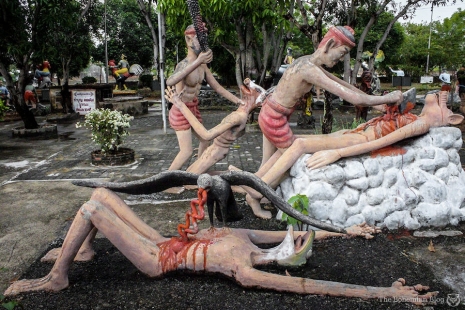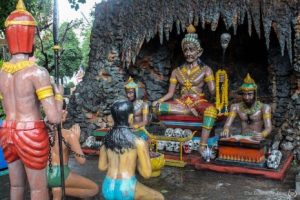DangerousMinds.net recently published a pictorial on a “Hell Garden” in Thailand. This is basically an “abusement park” that depicts the various punishment awaiting Buddhist sinners. One disclaimer; the article repeatedly talks about “Buddhist” theological doctrines as if this was a a small, simple, cogent thing whereas Buddhism is a sprawling, complex set of sects many with wildly various theories and practices of their own (rather like Christianity or Islam, in fact). So for folks whose main acquaintance with concepts of Buddhist afterlife is the Bardo Thodol… prepare for a shock (all though a lot of the imagery involved does resonate with the confrontation with the Wrathful Deities described). DM sez:
“Located about 60 miles outside of Bangkok there is a massive “garden” full of statues engaged in grisly situations that would make Hieronymus Bosch blush. The scenes are meant to depict the consequences of straying from the path of Buddhism—such as abusing alcohol or drugs and having loose morals. The bottom line is that at the end of your life (as a Buddhist) if your “bad deeds” outnumber your “good deeds” you’re fucking screwed. And in the case of some of the depictions in the Wang Saen Suk “Hell Garden” getting “screwed” could be quite literally what happens to you in the afterlife.
“In Buddhism ‘Hell’ goes by the name “Naraka” however it’s not a place where poorly behaved Buddhists end up spending eternity cavorting with the devil, but a place where the deceased must reside until all of their illicit actions (or “negative karma”) has been exhausted. In some cases inhabitants of Naraka must swap out their human bodies for those of animals that have been selected depending on the nature of your crime or bad behavior. So if you’re a criminal that is prone to starting bar fights, then you’ll turn into a duck. The offence of “corruption” will earn you the honor of sporting a rabid pig’s head instead of your own human one. But these Incredible Mr. Limpetsounding punishments pale in comparison to the true horrors that are depicted within the confines of Wang Saen Suk and its stoic misanthropes.”
Read the entire article here:
Thanks to Soror Amy for the tip!


